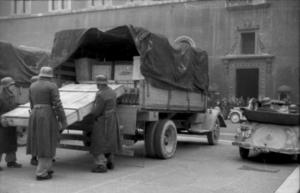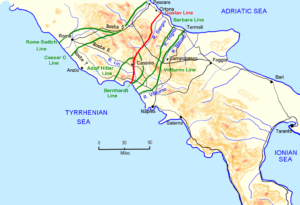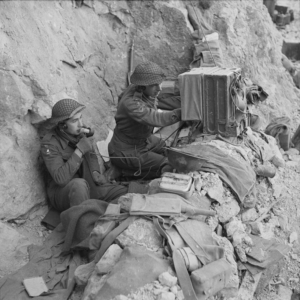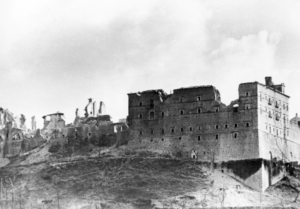Sequence of Events
During the Italian campaign, the Allied forces came across multiple defensive lines created by the Germans. None of them were as deadly as the Gustav Line that ran through Cassino. With the increase in victims and under German artillery fire, the decision was made to bomb the Abbey. Below is the sequence of events that preceded the destruction.
-
Operation Husky
The Allied landings in Sicily, code-named Operation Husky, was the largest campaign of the Second World War, with which the Allies rescued Sicily from the power of the Axis Italy and Nazi Germany. Operation Husky began the night between the 9th and 10th of July 1943 and ended on August 17. This action started the Italian campaign. -
3rd of September 1943
Troops and tanks landed under the bombing in Salerno, in view of the invasion of continental Italy. The main invasion took strength on the outskirts of Salerno on September 9th on the west coast, with the name of Operation Avalanche, while two parallel operations took place in Calabria (Operation Baytown) and Taranto (Operation Slapstick).
3rd of September 1943
-
Autumn 1943
While the Allies advanced towards Cassino, a German stronghold, two officers of the Hermann Göring Panzer Division, Captain Maximilian Becker and Lieutenant Colonel Julius Schlegel, proposed to transfer the treasures of Montecassino to the Vatican and to Castel Sant’Angelo, also owned by the Vatican, before the front approached. The officers convinced the Church authorities and their own superiors to use the trucks of the division and the gas for the journey. They had to procure the material necessary to create boxes built by the carpenter’s soldiers and recruit local workers (who were paid with food rations and twenty cigarettes a day). Finally, they organized “the great evacuation of the library and the archives”, a treasure literally priceless.
-
December 1943
The allied troops crossed many defensive lines created by the Germans. The Winter Line consisted of a series of German and Italian military fortifications, built during the Second World War by the Todt Organization and under the command of Albert Kesselring. A series of three lines were designated for the defense of the western part of Italy, and were concentrated around the city of Cassino, for which the highway 6 passed, leading directly to Rome. The Gustav Line crosses Italy from the mouth of the Garigliano river in the Tyrrhenian Sea to the mouth of the Sangro river on the Adriatic Sea beyond the Apennines. The Bernhardt Line and the Hitler Line, traveled shorter distances. They ended in the north-east of Cassino, where they rejoined the Gustav Line.
December 1943
-
17 January 1944
Montecassino and the Gustav Line were attacked 4 times by the Allies, including the last attack involving twenty divisions that bombed along a front of twenty miles.
Montecassino, the historic Abbey on the mountain founded by St. Benedict of Nusia in 529 AD, dominated the underlying city of Cassino and the entrances to the valleys of the Liri and Rapido river.
Being in a historically protected area, it was not occupied by the Germans even though they sought strategic positions a few steps from the Abbey in the valleys below. Due to repeated artillery attacks by Allied assault troops, the leaders of the latter came to the conclusion that the Abbey was used by the Germans, at least as an observation point. The fear increased due to the increasing number of deaths and although in the absence of concrete evidence, the destruction of the Abbey was decided.
-
February 15th
February 15th
-
February 17th
At dawn on the day after the bombing, many of the surviving civilians fled from the ruins. Only 40 people remained: the six monks who had survived in the deep vaults of the Abbey, the seventy-nine-year-old abbot, Bishop Gregorio Diamare, three peasant families, orphaned and abandoned children, the mortally wounded and the dying. After the destruction, new attacks and bombings by the 4th Indian Division, the monks decided to abandon their devastated home at 5.30pm on February 17th.
-
May 15th

On May 15, the 78th British Division joined the 13th British Corps line to make the final move to isolate Cassino from the Liri Valley.
May 15th
-
May 17th
On the 17th of May, the Polish Corps unleashed the second attack on Montecassino. Under constant artillery shells and mortar shells from the fortified positions of the Germans and with natural coverings as protection, the fight was hard and sometimes even hand-to-hand. Aware that their line was threatened by the Allied advance in the Liri Valley, the Germans decided to withdraw from the heights of Cassino to the new defensive positions in the Hitler Line.
In the early hours of May 18, the 78th British Division and the Polish Corps reached the Liri Valley two miles (3.2 km) west of Cassino. Here, the survivors of the second Polish offensive were so weak that it took time to find men strong enough to climb the last 100 meters to the top. A Polish patrol of the 12th Cavalry Regiment eventually reached the summit and raised the Polish flag among the ruins. The only remaining defenders were a group of thirty wounded Germans who were unable to escape. At the end of the war a Polish cemetery was built in Montecassino, on the slope of the mountain.
-
May 18th
The Germans were finally driven out of their positions, but at a very high price. The conquest of Montecassino cost the lives of 55,000 Allies, while the Germans had fewer losses, about 20,000 dead and wounded.
May 18th















